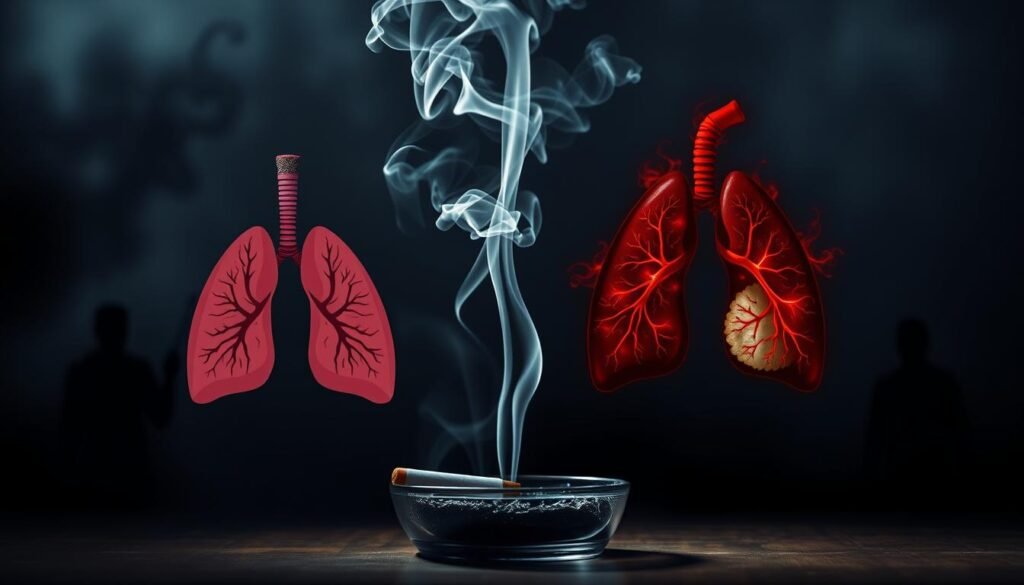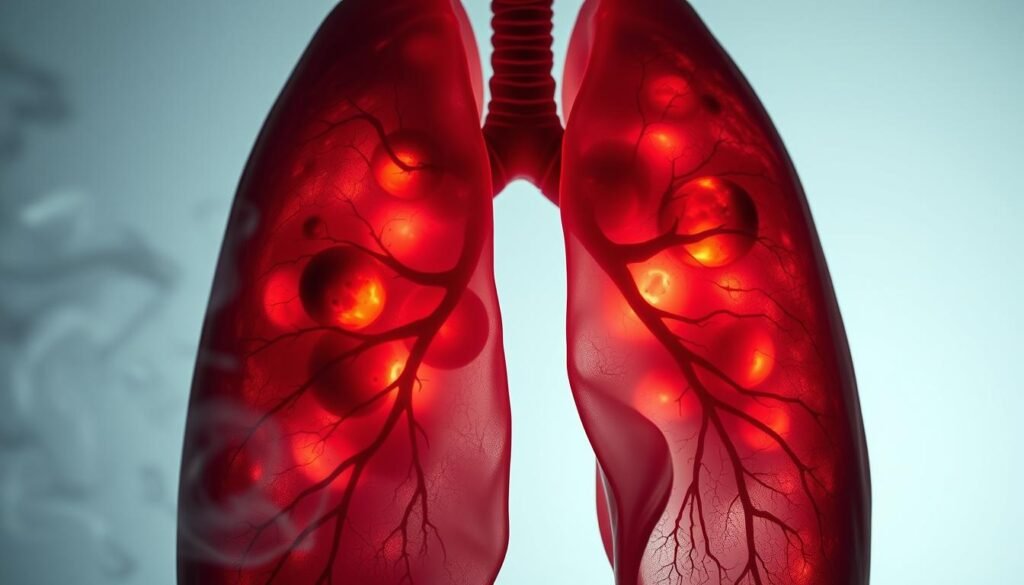About 85 percent of lung cancer cases are linked to smoking. This fact shows how important it is to know about lung cancer risks for people who used to smoke. With smoking being a top cause for lung cancer, grasping the details can be hard. The CDC says smoking causes around 480,000 deaths every year. This is a sad reminder of how bad smoking is. This write-up looks into how quitting smoking affects your lung cancer risk. It talks about the good things that come from stopping smoking and why spotting lung cancer early matters. By knowing these things, anyone who has stopped smoking can make better health decisions. They can also keep a closer eye on their lung health.
Key Takeaways
- Risk of lung cancer remains significant for former smokers, even years after quitting.
- Quitting smoking before age 40 can reduce the risk of smoking-related diseases by 90%.
- Routine lung cancer screenings are recommended for former heavy smokers.
- Awareness of symptoms is crucial for early detection of lung cancer.
- Former smokers have a three-times higher lung cancer risk compared to non-smokers.
- Maintaining regular communication with healthcare providers is essential for managing lung health.
- Adopting a smoke-free lifestyle can significantly improve overall health over time.
Introduction to Lung Cancer Risks
Lung cancer is a major health issue, mainly caused by smoking and environmental factors. Around 80% of lung cancer deaths are due to smoking. This highlights smoking’s big role as a risk factor. Even after quitting, many former smokers still face risks.
Stopping smoking doesn’t erase the risks right away. The body might still show signs that increase lung cancer risk. It’s important for previous smokers to understand their ongoing risk. They have a higher chance of getting lung cancer than those who never smoked.
Other things also raise lung cancer risk, not just smoking. Being around secondhand smoke is the third leading cause of lung cancer in the U.S. Also, people exposed to *asbestos* or who have had chest radiation face higher risks.
It’s vital for former smokers to know about these risks. If you know your risk, especially with a personal or family history, you can make better choices. Former smokers need to watch their health closely to lower lung cancer dangers.
Understanding the Link Between Smoking and Lung Cancer
It’s crucial to know how smoking and lung cancer are linked. About 85 to 90 percent of lung cancers come from smoking. Smoking brings harmful carcinogenic substances into the body. This greatly raises the chance of getting this terrible disease.
Smoking men are up to 23 times more likely to get lung cancer than those who don’t smoke. This fact shows how important it is to understand the tobacco effects on lungs. It’s also key to know that even young people who don’t smoke can get lung cancer.
Things like inhaling sand, beryllium, and asbestos at work can also lead to lung cancer in nonsmokers. Scientists are still looking into how genes may play a role. Even though smoking is the biggest risk, there are other things in the environment that could harm lung health.
We need to keep researching the link between smoking and lung cancer. Quitting smoking does lower the risk, but past smoking can still harm your lungs. People should keep an eye on their lung health and understand smoking’s lasting impact.
Risk of Lung Cancer in Former Smokers
The risk of lung cancer for people who have stopped smoking is still high. Learning about their lung cancer statistics helps us see their risk. Even though they are not smoking now, their chance of getting lung cancer is not gone. It’s lower than those who still smoke but higher than non-smokers.
Statistics on Former Smokers and Lung Cancer
About 85% of lung cancers are due to smoking, for both current and former smokers. The chance of getting lung cancer for former smokers depends on when they quit. Here are some examples:
- Men who quit at 60 face about a 10% lung cancer risk.
- Quitting at 50 lowers the risk to 6%.
- Stopping at 40 drops the risk to 3%.
- Quitting by 30 reduces the risk to 2%.
On the other hand, people who still smoke have a lung cancer risk of nearly 16% by 75. This risk can change depending on where you live, like:
| Country | Cumulative Risk of Lung Cancer (Current Smokers) by Age 75 |
|---|---|
| UK | 15.7% |
| Germany | 14.3% |
| Italy | 13.8% |
| Sweden | 6.6% |
Comparative Risk Levels: Former Smokers vs. Current Smokers
Former smokers have a higher risk of lung cancer than those who never smoked. Studies show this risk is about three times higher. For example, quitting before 40 can cut the risk by 80%. Quitting before 50 can reduce the risk by 57% in Italy and 69% in Germany.
Within five years of stopping smoking, about 39.1% of former smokers see their lung cancer risk drop. This shows how vital it is to stop smoking early. It also points to the need for regular health check-ups for those who smoked a lot before quitting.
Benefits of Quitting Smoking
Quitting smoking improves your health a lot. It starts working almost right away. Better lung function and living longer are some big wins. Lowering the chances of getting lung cancer is a major reason to quit.
How Smoking Cessation Affects Lung Cancer Risk
Stopping smoking lowers your lung cancer risk. It also reduces the chance of getting other cancers. Quitting before 40 cuts the risk of dying from smoking diseases by about 90%. Quitting helps your health in many ways, not just with cancer.
Immediate and Long-term Health Benefits After Quitting
The benefits of quitting smoking start fast. In 20 minutes, your heart rate and blood pressure get better. You’ll enjoy better taste, smell, and breath too. This means better hygiene.
Long-term benefits include living up to 10 years longer. Being in smoke-free places feels great. Being more active without getting out of breath is another plus. Quitting leads to a healthier life.

Lung Cancer Screening Recommendations
Lung cancer screening is very important for catching it early. This is especially true for people who used to smoke. Screening guidelines say that if you’re between 50 and 80 years old and smoked a lot in the past, you should get a special scan every year. A lot more people, nearly five million every year, now fit into this group for screening.
If you’ve smoked a lot over the years, you should get checked every year. This is true no matter how long ago you quit. This change helps more people learn if they need screening. It’s important because not everyone knows if they’re at risk or should get screened.
One study found that not enough people get screened because their doctors don’t talk to them about it. Doctors and their teams should work together to make sure patients know if they need screening. Having a set way to talk about lung cancer screening in the clinic can make it easier to refer people and follow up on their care.
People who are more likely to get lung cancer or who expect to live longer often choose to get screened. Knowing this helps doctors and their teams talk to patients better. They can make sure the right people know how important screening is.
Importance of Early Detection
Spotting lung cancer early greatly raises the success of treatment and survival rates. Screening methods vary with low-dose CT scans being top-rated. They excel over conventional chest X-rays by spotting small tumors earlier. This makes timely treatment possible.
Screening Methods: Low-Dose CT Scans vs. Chest X-Rays
For lung cancer screening, low-dose CT scans are preferred, especially for those who smoked a lot. They’re advised annually for 50 to 80-year-olds who’ve smoked for 20 or more pack-years. Unlike chest X-rays, low-dose CT scans can spot cancer early, as they offer a clearer picture.
Who Should Get Screened?
Screening is key for those at high risk. This includes people aged 50 to 80 with a long smoking history. If you’re a smoker or stopped within the last 15 years, you should think about getting screened. Also, those with lung cancer in the family, a history of lung problems, or asbestos exposure are urged to be screened.
Meeting these criteria means one could greatly benefit from early detection. Early detection opens up more treatment options and leads to better results. For more info, click here.
| Criteria for Lung Cancer Screening | Details |
|---|---|
| Age | 50 to 80 years old |
| Smoking History | 20 pack-year history |
| Former Smokers | Quit within 15 years |
| Additional Risk Factors | Family history, asbestos exposure |
| Screening Recommendation | Yearly low-dose CT scans |
Genetic and Environmental Risk Factors
It’s important to understand how genetics and environment affect lung cancer risk. Certain genes make people more likely to get lung cancer. These genes increase sensitivity to tobacco smoke’s harmful effects, raising the risk for former smokers.
The Role of Genetics in Lung Cancer Vulnerability
Genes play a key part in determining lung cancer risk. People with lung cancer in their family are more at risk. If you have close relatives with lung cancer, your risk is even higher. Knowing your family’s health history is crucial for early detection.
Environmental Exposures that Increase Lung Cancer Risk
Things in the environment also add to lung cancer risk. Asbestos, radon, and secondhand smoke are proven dangers. For example, most mesothelioma cases are from asbestos at work. And, radon in homes is a leading cause of lung cancer in non-smokers. Smokers and non-smokers alike need to watch out for these hazards.
| Risk Factor | Description | Impact on Lung Cancer |
|---|---|---|
| Genetic Factors | Family history of lung cancer or specific genetic mutations | Increases the likelihood of developing lung cancer |
| Asbestos Exposure | Exposure to asbestos in the workplace | Linked to 70-80% of mesothelioma cases |
| Radon Exposure | Indoor radon contributes to lung cancer deaths | Responsible for 30% of lung cancer deaths in never-smokers |
| Secondhand Smoke | Inhaling smoke from others who are smoking | Increases lung cancer risk in non-smokers |
| Arsenic in Drinking Water | Exposure to arsenic can elevate lung cancer risks | Potentially increases overall lung cancer risk |
Knowing about genetic and environmental risks can lead to early prevention and screening. This knowledge is a key part of fighting lung cancer.
Secondhand Smoke Exposure and Its Risks
Secondhand smoke is still a big health worry, even for people who’ve quit smoking. Studies show that being around secondhand smoke can still greatly affect someone’s health. It can increase their chances of getting lung cancer and heart diseases.
This part talks about how secondhand smoke affects those who have quit smoking. And it looks into the serious health risks tied to being exposed to this kind of smoke.
How Secondhand Smoke Affects Former Smokers
For people who’ve stopped smoking, being around smokers is still risky. A study found that the chance of getting lung cancer is higher for those exposed to secondhand smoke early in life. But if the exposure starts after age 25, the risk is much lower.
This shows how important it is to avoid secondhand smoke from a young age. It has a lasting effect on health.
Proven Health Risks Associated with Secondhand Smoke Exposure
Secondhand smoke dangers go beyond lung cancer. For nonsmokers who are often around smoke, the risk of lung cancer and heart diseases goes up a lot. Being exposed to secondhand smoke makes non-smoking adults 25-30% more likely to get heart disease.
This exposure also causes about 34,000 early deaths from heart disease in the U.S. each year. Children are especially at risk. They face more lung infections, asthma, and other health issues because of secondhand smoke.
| Health Risk | Affected Population | Risk Increase |
|---|---|---|
| Lung Cancer | Non-smoking adults | 7,300 deaths annually |
| Coronary Heart Disease | Non-smoking adults | 25-30% increase |
| Stroke | Non-smoking adults | 20-30% increase |
| Lower Birth Weight | Pregnant women | Higher risk |
| Respiratory Issues | Children | Increased risk of pneumonia, asthma |

Screening Tools for Assessing Lung Cancer Risk
It’s key for former smokers to assess their lung cancer risk to stay ahead health-wise. Many web tools help evaluate this risk, mainly for those aged 50 to 80 with a heavy smoking history. These tools are a first step towards talking with doctors about lung cancer screening needs.
Online Risk Assessment Tools for Former Smokers
Various websites offer assessments specially designed for ex-smokers. They ask for details on your smoking past, health, and other risk factors. This information then helps predict your chance of getting lung cancer. Research shows using these tools can boost awareness and lead to early screening.
Factors that Influence Your Lung Cancer Risk
Knowing what increases lung cancer risk is critical. Important factors include:
- Duration of smoking: The longer you’ve smoked, the higher the risk.
- Frequency of use: Smoking more often raises the risk as well.
- Family medical history: Having relatives with lung cancer might mean you’re more likely to get it too.
- Environmental exposures: Being around things like asbestos or pollution also affects your risk.
Looking into a detailed screening tool like ENGAGE can help understand your risk better. It assesses former smokers’ risk levels and suggests when to have screenings. Being informed helps you make the best choices for your health.
Symptoms and Warning Signs of Lung Cancer
Knowing the symptoms of lung cancer is key for catching it early. This can lead to better survival rates. Sometimes, people don’t feel sick until the cancer is advanced. Yet, early-stage lung cancer can show signs that need a doctor’s look.
Watch out for these common signs:
- Persistent cough that does not go away
- Coughing up blood or rust-colored sputum
- Chest pain that may worsen with deep breathing or coughing
- Hoarseness or changes in voice
- Loss of appetite accompanied by unexplained weight loss
- Shortness of breath or wheezing
- Fatigue that does not improve with rest
- Recurring respiratory infections, such as bronchitis or pneumonia
More symptoms can appear as lung cancer gets worse. This is especially true if it has spread to other parts of the body.
- Bone pain
- Neurological changes
- Jaundice or yellowing of skin and eyes
- Swelling of lymph nodes
- Specific syndromes like Horner syndrome or Superior Vena Cava syndrome
Pancoast tumors grow at the top of the lungs and cause severe shoulder pain or Horner syndrome. Different parts of the body may be affected by paraneoplastic syndromes. This leads to a variety of neurological or endocrine symptoms.
Spotting lung cancer symptoms early is critical. They often look like other health issues. If you have these symptoms, see a doctor for the right diagnosis and treatment. For extra information on lung cancer, check out this source.

Communicating with Healthcare Providers
Understanding lung cancer risk is key, especially for smokers. It’s important to talk openly with doctors about smoking. This includes how long you’ve smoked or if you’ve quit. This lets health pros find the best screening methods, focusing on lung health.
Discussing Smoking History and Risk
During medical visits, sharing all about your smoking is crucial. Former smokers often don’t know their lung cancer risk. Sadly, over 80% of smokers haven’t talked about screenings with their doctors. By speaking up about their smoking and any symptoms, patients can get ahead with screenings and care.
When to Seek Medical Advice for Lung Health
Don’t wait to get help if you have symptoms like continuous coughing, breathing trouble, or big appetite changes. These signs can mean serious problems. Getting help early means better chances for successful treatments. Check out this helpful resource for lung cancer signs.
Conclusion
Understanding lung cancer risks in former smokers is essential for good health management. Quitting smoking cuts lung cancer risks by up to 42%. But, it doesn’t remove the risks completely. Former smokers are still more at risk than those who never smoked. This shows why keeping up with health checks is important.
Early detection plays a big role for ex-smokers. It can significantly lower the chance of dying from lung cancer. Tests can reduce this risk by up to 20%. Talking openly with doctors about past smoking and symptoms is crucial. It helps stick to a health plan that works best for you.
By being proactive, former smokers take a big step towards better lung health. Knowing lung cancer signs and how past smoking affects them is important. They can then make smart choices for their health. Being aware and acting early are the best ways to deal with health risks from smoking before.